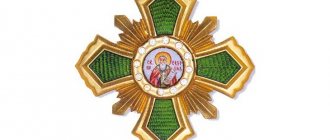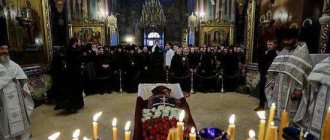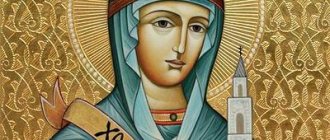| This article includes a list of general recommendations, but it remains largely untested because it lacks relevant inline quotes . |
The archimandrite is in full vestments, holding on to the pastoral staff, and minimally invested in the epitrachelium and epimanikium.
His miter is on the table to his right. Title Archimandrite
(Greek: ἀρχιμανδρίτης, romanized: archimandrite), primarily used in the Eastern Orthodox and Eastern Catholic churches, originally called the authority of the abbot (
igumenos
, Greek: ἡγούμενος, present participle meaning of the verb
to lead
) whom the bishop is appointed to preside over several "ordinary" abbots and monasteries, or the abbot of some particularly large and important monastery.
It is also used purely as an honorary title, having no connection to any actual monastery, and is given to the clergy as a sign of respect or gratitude for service to the Church. This special sign of respect is given only to those priests who have taken vows of celibacy, that is, monks. Prominent married clergy may receive the title of Archpriest.
Story
The term comes from the Greek: the first element from ἀρχι arch-
means "highest" or from
archon
"ruler";
and the second root from μάνδρα mandra
meaning "enclosure" or "enclosure", "enclosure" and designation of "monastery" (compare the use of "flock" for "assembly").
The name has been widely used since the 5th century, but is first mentioned in a letter to Epiphanius, with his prefix Panarius
(c. 375), but
the History of Lausiac
from Palladium may indicate its spread in the 4th century in relation to St. Pachomius.[1]
When the leadership of the monasteries passed to another episcopal official - the Great Sakellarios ("sacristan") - the title of archimandrite became an honorary title for the abbots of important monasteries (compared to the ordinary abbot, hegumenos).
Excerpt characterizing the Archimandrite
For a long time Pierre could not understand what was happening to him. From all sides he heard the cries of joy of his comrades. - Brothers! My dears, my dears! - the old soldiers cried, crying, hugging the Cossacks and hussars. Hussars and Cossacks surrounded the prisoners and hurriedly offered them dresses, boots, and bread. Pierre sobbed, sitting among them, and could not utter a word; he hugged the first soldier who approached him and, crying, kissed him. Dolokhov stood at the gate of a ruined house, letting a crowd of disarmed French pass by. The French, excited by everything that had happened, spoke loudly among themselves; but when they passed by Dolokhov, who was lightly whipping his boots with his whip and looking at them with his cold, glassy gaze, promising nothing good, their conversation fell silent. On the other side stood the Cossack Dolokhov and counted the prisoners, marking hundreds with a chalk line on the gate. - How many? – Dolokhov asked the Cossack who was counting the prisoners. “For the second hundred,” answered the Cossack. “Filez, filez, [Come in, come in.],” Dolokhov said, having learned this expression from the French, and, meeting the eyes of passing prisoners, his gaze flashed with a cruel brilliance. Denisov, with a gloomy face, having taken off his hat, walked behind the Cossacks, who were carrying the body of Petya Rostov to a hole dug in the garden. From October 28, when frosts began, the flight of the French only took on a more tragic character: people freezing and roasting to death at the fires and continuing to ride in fur coats and carriages with the looted goods of the emperor, kings and dukes; but in essence, the process of flight and disintegration of the French army has not changed at all since the speech from Moscow. From Moscow to Vyazma, out of the seventy-three thousand strong French army, not counting the guards (which throughout the war did nothing but plunder), out of seventy-three thousand, thirty-six thousand remained (of this number, no more than five thousand died in battles). Here is the first term of the progression, which mathematically correctly determines the subsequent ones. The French army in the same proportion melted and was destroyed from Moscow to Vyazma, from Vyazma to Smolensk, from Smolensk to Berezina, from Berezina to Vilna, regardless of the greater or lesser degree of cold, persecution, blocking the path and all other conditions taken separately. After Vyazma, the French troops, instead of three columns, huddled together in one heap and continued like this until the end. Berthier wrote to his sovereign (it is known how far from the truth the commanders allow themselves to describe the situation of the army). He wrote:
Russian usage
Archimandrite's staff, Armenia, 19th century
In 1764, the Russian Orthodox Church organized its monasteries and classified them into one of three classes, awarding the title of archimandrite only to abbots of monasteries of the second or first class. The abbots of third-class monasteries were to be called abbots.
The duties of the abbot and the archimandrite are the same; however, during Divine services, the abbot wears a simple robe, and the archimandrite's robe is decorated with sacred texts; the archimandrite also wears a miter and carries a pastoral staff ( Pateritsa
).
The Russian Orthodox Church usually selects bishops from the ranks of archimandrites.
The meaning of the word archimandrite
The old woman is rightfully proud of many glorious names: the monk Theodorit, who began the construction of the temple “in honor of the Dormition of the Mother of God”; the first Archimandrite Leonid, under whom Tver Bishop Simeon will open a second see in Staritsa; Abbot Serapion, who died on the walls of the monastery from Tatar arrows along with 124 monks; the chronicler-schema monk Dorotheos, who compiled the first narrative about the founding of the monastery; Archimandrite Isaiah, who built the Church of St. John the Evangelist at his own expense; Bishop of Starorussky, Vicar of Novgorod Arseny 2nd; Bishop of Mogilevsky Joasaph; teacher at the Academy of Arts, Archimandrite Seraphim; Archimandrite of the Valaam Monastery Damascene; Bishop of Ekaterinoslav Innocent; the last archimandrite of the Staritsky Monastery, Pavel, martyred on Solovki, and many, many others...
The old woman is rightfully proud of many glorious names: the monk Theodorit, who began the construction of the temple “in honor of the Dormition of the Mother of God”; the first Archimandrite Leonid, under whom Tver Bishop Simeon will open a second see in Staritsa; Abbot Serapion, who died on the walls of the monastery from Tatar arrows along with 124 monks; the chronicler-schema monk Dorotheos, who compiled the first narrative about the founding of the monastery; Archimandrite Isaiah, who built the Church of St. John the Evangelist at his own expense; Bishop of Starorussky, Vicar of Novgorod Arseny 2nd; Bishop Joasaph of Mogilev; teacher at the Academy of Arts, Archimandrite Seraphim; Archimandrite of the Valaam Monastery Damascene; Bishop of Ekaterinoslav Innocent; the last archimandrite of the Staritsky Monastery, Pavel, martyred on Solovki, and many, many others...
These are the elders Archimandrite Cosmas, Archimandrite Tavrion, Archimandrite Seraphim, this is Archpriest Nikolai Guryanov, Archimandrite Zinon, Abbess Varvara.
And when Archimandrite Ignatius was getting ready to go to the Trinity-Sergius Lavra, Metropolitan Philaret wrote to the viceroy, Archimandrite Anthony: “You will have Archimandrite Ignatius of the Sergius Hermitage.
Archimandrite Gideon, of course, did not want to let go of the fat piece from his hands and, despite his hierarchically subordinate position, waged a fierce lawsuit with the Eminence, and, presumably, the archimandrite did not miss the opportunity to supervise the scandalous lifestyle of the bishop, in order to take advantage of this when necessary .
In Zvenigorod “at Sava Storozhevsky” Philaret was met by Archbishop of Vologda and Great Perm Macarius, Chudov Archimandrite Avramy, Ipatiev Archimandrite Joseph, boyar V.P. Morozov and Duma nobleman G.G. Pushkin.
Such elders as Archimandrite John (Krestyankin), like Archimandrite Kirill (Pavlov), like Archpriest Nikolai (Guryanov) from the island of Zalit, never accepted personal veneration; they considered themselves unworthy of it.
These are the words in which Archimandrite Leonid reports the results of his research: “Having read the above-mentioned articles of Archimandrite Antonin in the Proceedings of the Kiev Theological Academy with the curiosity and attention with which all articles of the venerable Archimandrite Antonin, known for his deep learning and critical talent, are read, we asked ourselves the question: after Since it has now become known, thanks to Archimandrite Antoninus, that in ancient Greek writing there are lists of the “Other Life” of St. Nicholas the Wonderworker, it cannot be that it remained completely unknown to our inquisitive ancestors, due to the special reverence that the name has always enjoyed in Rus' St. Nicholas the Wonderworker, about which we have evidence coming from ancient times.
In place of Archimandrite Seraphim, who was appointed by the Holy Synod to be the abbot of a monastery in Crimea, near Balaklava, and who is leaving there the other day, Archimandrite Nikon, who had hitherto served as the abbot of the Simonov Stavropegic Monastery, was appointed rector of the Sretensky Monastery.
Reporting this to the public, Archimandrite Antoninus stated that he did not lose hope that sooner or later he would find a complete list of this “Other Life” in Greek in the libraries of Athenian monasteries, or that one would be found in other libraries of the East or West, but for now he considered it possible to conclude, that undoubtedly (?) there were two Saint Nicholas, miracle workers of Myra, who lived at a distance of 200 years from each other: 1) Saint Nicholas, who lived during the time of the emperors Diocletian and Constantine the Great in the 3rd-4th century, and 2) Saint Nicholas (of the archimandrites Zion Monastery), who lived in the 6th century under Emperor Justinian.
Greek usage
An archimandrite is a priest who has taken monastic vows and can theoretically be ordained a bishop. Churches under the ecclesiastical jurisdiction of the four Eastern Orthodox Patriarchates usually require such a monastic priest to have a graduate degree in theology before he is elevated to the rank of archimandrite. Sometimes the requirement is waived if the priest can show outstanding achievement in other academic fields, such as the humanities or science.
Description of the rank
The rank of archimandrite appeared in the Eastern Church in the 5th century (there is some evidence that it existed already in the 4th century) - this was the name given to the persons chosen by the bishop from among the abbots to oversee the monasteries of the diocese. Subsequently, the name “archimandrite” passed to the heads of the most important monasteries, and then to monastics holding church administrative positions.
It is known about the existence in the ancient church of female archimandritis (Greek: ἀρχιμανδρίτισσα or ἀρχιμανδρῖτις). Some of the abbess of women's monasteries had this rank, for example, the Venerable Eupraxia of Tavenis.
In 1764, according to the Manifesto on the secularization of monastic lands, Russian monasteries were distributed into three classes; the heads of monasteries of the 1st and 2nd classes began to be called archimandrites.
The archimandrite wears a black robe, like all monastics, but with red tablets, which are reserved only for bishops. Along with the elevation to the rank of archimandrite, the miter is awarded, and if the archimandrite is the viceroy or abbot of a monastery, he enjoys the right to wear a staff-staff within his monastery, including during divine services.
In the Byzantine rite of the Catholic Church there is the rank of protoarchimandrite.
In the Armenian Apostolic Church, the rank of archimandrite - vardapet is given to persons who have the academic degree of Doctor of Theology. The proto-archimandrite in the AAC is called Tsayraguin Vardapet.
Western use
| Part of the series on |
| Hierarchy of the Catholic Church |
| St. Peter |
| Ecclesiastical titles (order of priority) |
|
Liturgical titles
|
Administrative and pastoral titles
|
Consecrated and professed titles
|
Additional Headings
|
Names of organizations
|
|
|
An archimandrite who is not abbot has the style "Venerable Archimandrite", while one who serves as abbot uses the style "Venerable Archimandrite".
The word appears in Regula Columbani
(p. 7), and du Cange cites several other instances of its use in Latin documents, but it never came into fashion in the West; however, due to associations with Greek and Slavic Christianity, the name sometimes appears in southern Italy and Sicily, as well as Croatia, Hungary and Poland.[1]
Recommendations
- ^ a b
One or more of the preceding sentences incorporate text from a publication now in the public domain: Chisholm, Hugh, ed.
(1911). "Archimandrite". Encyclopedia Britannica
.
2
(11th ed.). Cambridge University Press. paragraph 368.
- This article includes text from a publication that is now in the public domain: Encyclopedic Dictionary of Brockhaus and Efron
(in Russian). 1906 Missing or empty | title = (help) - Dictionnaire d'archéologie chrétienne et de liturgie
(In French)







